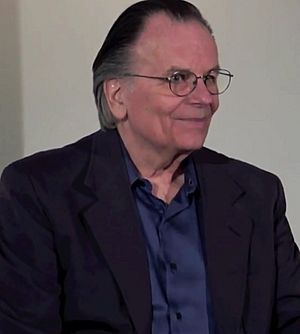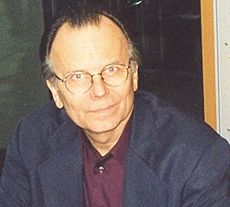Gary Kurtz facts for kids
Quick facts for kids
Gary Kurtz
|
|
|---|---|

Kurtz in 2012
|
|
| Born |
Gary Douglas Kurtz
July 27, 1940 Los Angeles, California, U.S.
|
| Died | September 23, 2018 (aged 78) |
| Occupation | Film producer |
| Years active | 1965–2018 |
| Spouse(s) |
Meredith Alsup Kurtz
(m. 1963; div. 1983)Roberta Jimenez Kurtz
(m. 1984; div. 1992)Clare Gabriel
(m. 2003) |
| Children | 3 |
| Awards | See Awards |
Gary Douglas Kurtz (born July 27, 1940 – died September 23, 2018) was an American film producer. He helped create some very famous movies. These include American Graffiti (1973) and the first two Star Wars films: Star Wars (1977) and The Empire Strikes Back (1980). He also produced The Dark Crystal (1982) and Return to Oz (1985). Later, he worked on Slipstream (1989), which brought him back together with Star Wars actor Mark Hamill.
Contents
Early career in movies
Gary Kurtz started working in movies in 1965. He was an assistant director for a Western film called Ride in the Whirlwind. An assistant director helps the main director keep the film on schedule and organize the set. He also worked as a production manager on other films. A production manager makes sure the film stays within its budget and schedule.
From 1966 to 1969, Kurtz served in the U.S. Marine Corps. He was a Quaker, a religion that believes in peace. So, he joined as a conscientious objector, meaning he refused to carry a weapon. Instead, he worked as a combat cameraman, filming during battles.
After his military service, Kurtz returned to filmmaking. He became an associate producer on films like Chandler and Two-Lane Blacktop in 1971. An associate producer helps the main producer with many tasks.
Working with George Lucas and Lucasfilm
American Graffiti: A big surprise hit
Gary Kurtz first worked with director George Lucas on the 1973 film American Graffiti. They wanted to make a movie about teenagers in the 1960s. Many studios weren't interested at first. One studio thought it wasn't exciting enough.
Finally, Universal Pictures agreed to make the film. They gave Lucas and Kurtz a small budget, but they also gave Lucas complete control over the movie. This meant Lucas could make the film exactly how he wanted. Famous director Francis Ford Coppola also joined as a co-producer.
American Graffiti was released in August 1973. It was a "sleeper hit," meaning it became very popular and earned a lot of money even though no one expected it to. The movie cost only about $1.27 million to make. But it earned over $55 million worldwide! It became one of the most profitable movies ever made.
Critics loved American Graffiti. Many called it one of the best teen films. It was praised for its nostalgia and its look at young people's last days of high school. Kurtz and Coppola were even nominated for an Academy Award for Best Picture. They also won a Golden Globe Award for Best Motion Picture – Musical or Comedy. In 1995, the film was chosen for the National Film Registry. This means it's considered important for American culture and history.
Around the same time, Kurtz started his own company called Kinetographics.
Star Wars: A galaxy far, far away
Kurtz continued working with George Lucas on Star Wars, which came out in 1977. This film was later called Episode IV – A New Hope.
Making Star Wars was tough. When filming began in Tunisia, they faced many problems. There was a rare rainstorm, props didn't work, and electronics broke down. Lucas also had disagreements with the camera director.
Despite these challenges, Star Wars was a huge success. It cost $11 million to make. But it earned over $460 million in the United States and $314 million overseas! It became the highest-grossing film at the time. Star Wars received many awards, including six Academy Awards. It is still considered one of the greatest films ever made. In 1989, it was also chosen for the National Film Registry.
The Empire Strikes Back: A difficult sequel
Kurtz's last film with Lucas was The Empire Strikes Back. This movie was very expensive and difficult to make. It took much longer to film than planned, which made the budget go way up. Lucas even had to borrow $10 million to finish the movie. Kurtz had to help direct some parts of the film to keep it moving.
The Empire Strikes Back was released in May 1980. It became the most praised film in the Star Wars series. Many people think it's one of the best films ever. It earned over $538 million worldwide. In 2010, this film was also chosen for the National Film Registry.
After this film, Kurtz and Lucas went their separate ways. Kurtz felt that Lucas wanted to focus more on selling toys and making movies that were just exciting, rather than telling deep stories. He also disagreed with some of the story changes Lucas made for the next Star Wars film, Return of the Jedi. Kurtz wanted a darker ending, but Lucas chose a happier one.
Films after Lucasfilm
After leaving Lucasfilm, Gary Kurtz continued to produce other interesting movies.
The Dark Crystal: A puppet fantasy
Kurtz's next big film was The Dark Crystal in 1982. This was a fantasy film directed by Jim Henson and Frank Oz, who are famous for creating The Muppets. The movie used amazing puppets and special effects.
The Dark Crystal came out during a busy Christmas season. It competed with other big movies like E.T. the Extra-Terrestrial. Still, it earned over $40 million in the U.S. and was very popular in other countries like France and Japan. Over the years, it has become a "cult film," meaning it has a strong and dedicated fan base.
Little Nemo: Adventures in Slumberland: A long journey
Kurtz was involved in making Little Nemo: Adventures in Slumberland, an animated film. This project had a very long and difficult production. Many writers and directors worked on it and then left. Kurtz himself stepped down in 1984. The film finally came out in Japan in 1989.
Return to Oz: Back to the Emerald City
In 1985, Kurtz produced Return to Oz. This fantasy adventure film was based on L. Frank Baum's Oz books, which are the stories that The Wizard of Oz came from. The film faced some challenges during production, and the director was even fired and then rehired for a short time.
Unfortunately, the film did not do well in theaters and was considered a "flop." However, it was nominated for an Academy Award for Best Visual Effects.
Slipstream: A difficult ending
Slipstream was another film Kurtz produced. Sadly, this movie was not successful. It did not earn much money and was not released in theaters in North America. Kurtz later said that the original script was much more violent, but those scenes were never filmed. The film has a low score on Rotten Tomatoes, a website that collects movie reviews.
Awards
Gary Kurtz and the films he produced received many awards and nominations. Here are some of the main "Best Picture" awards:
Filmography
Films
Producer
He was producer for all films unless otherwise noted.
| Year | Title | Credit | Notes |
|---|---|---|---|
| 1971 | Two-Lane Blacktop | Associate producer | |
| Chandler | |||
| 1973 | American Graffiti | Co-producer | |
| 1977 | Star Wars | a.k.a. Star Wars: Episode IV - A New Hope | |
| 1980 | The Empire Strikes Back | a.k.a. Star Wars: Episode V - The Empire Strikes Back | |
| 1982 | The Dark Crystal | ||
| 1985 | Return to Oz | Executive producer | |
| 1989 | Slipstream | ||
| 1993 | The Thief and the Cobbler | Uncredited | |
| 1995 | The Steal | ||
| 2014 | Centurion Resurrection | Short film | |
| 2016 | Gangster Kittens | Executive producer | |
| 2022 | 5-25-77 | Released posthumously |
Second unit director or assistant director
| Year | Title | Credit | Notes |
|---|---|---|---|
| 1965 | Beach Ball | Assistant director / second unit director | |
| 1966 | Ride in the Whirlwind | Assistant director | |
| 1967 | The Hostage | ||
| 1980 | The Empire Strikes Back | Assistant director / director: studio second unit | a.k.a. Star Wars: Episode V - The Empire Strikes Back |
| Uncredited | |||
| 1982 | The Dark Crystal | Second unit director |
Production manager
| Year | Title | Notes |
|---|---|---|
| 1965 | Voyage to the Prehistoric Planet | Edited from Планета бурь (1962, USSR film) |
| 1966 | Queen of Blood | |
| 1967 | The Hostage |
Actor
| Year | Title | Role | Notes |
|---|---|---|---|
| 1974 | The Godfather: Part II | Photographer in Court | Uncredited |
Camera and electrical department
| Year | Title | Credit | Notes |
|---|---|---|---|
| 1965 | Beach Ball | Camera operator: second unit | Uncredited |
| 1966 | The Shooting | Assistant camera |
Editor
| Year | Title |
|---|---|
| 1967 | The Hostage |
| 1970 | Imago |
Sound department
| Year | Title | Credit |
|---|---|---|
| 1966 | Blood Bath | Sound |
Thanks
| Year | Title | Credit | Notes |
|---|---|---|---|
| 1990 | Disney Sing-Along-Songs: Disneyland Fun | Special thanks | Video short film |
| 2004 | Empire of Dreams: The Story of the Star Wars Trilogy | Acknowledgment: stills and posters courtesy of / special thanks | Video documentary film |
| 2007 | Return to Oz: The Joy That Got Away | Dedicatee | Documentary film |
| 2015 | Qing bi shan gao | Special thanks |
Television
Producer
He was producer for all projects unless otherwise noted.
| Year | Title | Credit | Notes |
|---|---|---|---|
| 1977 | The Making of Star Wars | Executive producer | Television documentary film |
| 1992 | Mickey's Nutcracker | Television special short | |
| 2004 | The Tale of Jack Frost | Co-executive producer | Television film |
| Uncredited | |||
| 2007 | Friends and Heroes | Television series, 13 episodes | |
| 2008 | Resistance | Executive producer | Television series, urknown episodes |
Production manager
| Year | Title | Credit | Notes |
|---|---|---|---|
| 2008 | Friends and Heroes | Pre-production supervisor | Television series, 13 episodes |
Animation department
| Year | Title | Credit | Notes |
|---|---|---|---|
| 2000 | The Animated Odyssey | Animation supervisor | Television mini-series, 4 episodes |
Thanks
| Year | Title | Credit | Notes |
|---|---|---|---|
| 2004 | The Tale of Jack Frost | Thanks: Corsham Entertainment Ltd. | Television film |
Personal life
Gary Kurtz was married three times. He had two daughters, Tiffany and Melissa, and a son, Dylan. He was a Quaker. Born in Los Angeles, he moved to London, England when he worked on Star Wars. He decided to stay there and raise his family. Gary Kurtz passed away from cancer in London on September 23, 2018.
See also
 In Spanish: Gary Kurtz para niños
In Spanish: Gary Kurtz para niños


